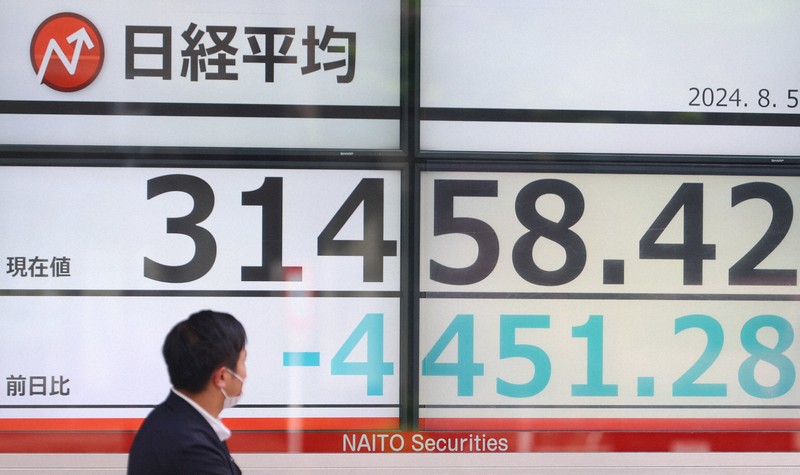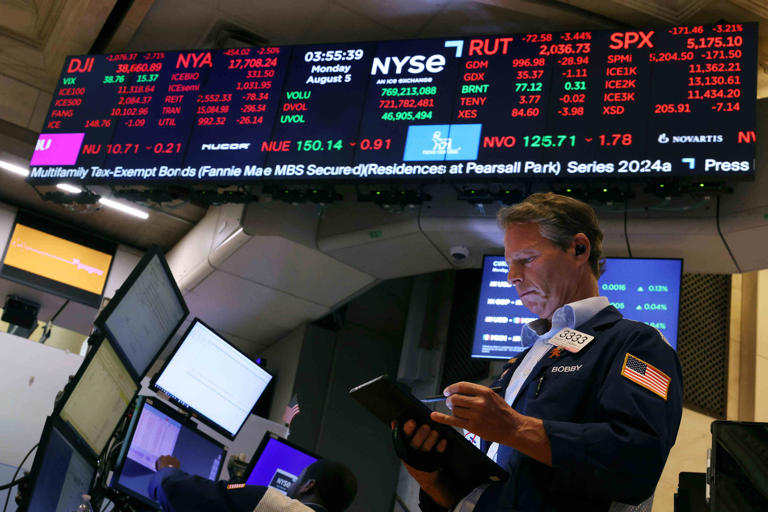
An electronic stock board shows the Nikkei 225 index after the Tokyo Stock Exchange crashed on Aug. 5, 2024, in Tokyo's Chuo Ward. (Mainichi/Kenji Ikai)
On Aug. 5, global stock markets were engulfed in a massive storm and experienced widespread turbulence. Markets in major economies, including the United States, Japan and Europe all plummeted, leaving investors in shock. As a barometer of global financial markets, the U.S. stock market’s performance was particularly noteworthy. On Aug. 5, the three major indices of the New York Stock Exchange all saw significant declines. By the close, the Dow Jones Industrial Average had fallen 2.60 percent from the previous day; the S&P 500 Index had dropped 3.00 percent; and the Nasdaq Composite Index had decreased by 3.43 percent. The “fear index” (VIX) surged by 181 percent, reaching its highest level since the outbreak of the COVID-19 pandemic in March 2020.
Recent U.S. stock market turbulence can be attributed to several factors. First, the U.S. GDP growth rate and nonfarm payroll data for the second quarter fell short of expectations, raising alarms that the U.S. economy might be heading into a recession. Slower economic growth led to concerns that future corporate profits would be affected. Second, disappointing earnings reports from several large tech companies triggered a selling wave of tech stocks. Giants such as Apple, Amazon, and Google showed sluggish profit growth, further fueling market pessimism. In the past month, more than $1 trillion of market capitalization in the Big Seven tech stocks has evaporated. Third, the Federal Reserve’s indecision on interest rate hikes added uncertainty about future rate trends. While the Fed hinted at a possible rate cut in September, it also cautiously denied this, sparking a market panic.
The turbulence on Wall Street had strong negative spillover effects on global markets. Japan and South Korea also experienced a bad Monday, with European stock indices falling by about 3 percent as they became part of the financial storm. On Aug. 5 the Nikkei 225 Index plummeted by 12.4 percent, dropping below the closing price of December 2023 (33,464 points) and wiping out all gains for 2024. The Tokyo Stock Exchange’s TOPIX Index also dropped by 12.23 percent, triggering the circuit breaker mechanism. All 33 industry sectors on the Tokyo Stock Exchange fell, with most sectors dropping more than 10 percent. South Korea’s KOSPI Index plunged by more than 10 percent, breaking below the psychological threshold of 2400 points and triggering a temporary trading halt. The KOSPI eventually closed at 2,441.55 points, down 8.77 percent. The KOSDAQ Index closed at 691.28 points, down 11.30 percent.
On that day, South Korea’s Composite Index fell by more than 4 percent, with Samsung Electronics and Kia Motors both dropping nearly 5 percent and SK Hynix, Hyundai Motors and Celltrion all falling by more than 3 percent, reflecting the overall weakness in the South Korean stock market.

Michael M. Santiago / Staff / Getty Images Traders work on the floor of the New York Stock Exchange on Aug. 5, 2024
Has the storm passed?
After Aug. 5, global markets gradually stabilized, but this does not necessarily mean that the storm had fully passed. It could merely have been the prelude to a larger storm.
The market stabilization can be attributed to several factors. First, financial markets possess a certain degree of self-repair capability. After experiencing short-term and severe volatility, investors often reassess the fundamentals and future outlook of the market. The rapid stabilization of the market may reflect that investors believe the previous panic selling was overdone and that the decline in stock prices exceeded the levels supported by the actual economic conditions. As a result, funds flowed back into the market, driving a recovery. Second, the central banks and governments of major economies may have swiftly taken measures to calm the markets after the downturn. For instance, through verbal interventions, liquidity support or the announcement of economic stimulus plans, market confidence was boosted. Such measures can alleviate market panic, stabilize investor expectations and support market stabilization.
However, it would be premature to conclude that the storm has ended. Historically, market turbulence often precedes larger financial crises. Similar to the signs before the 2008 financial crisis, today’s market volatility and economic uncertainty are reminiscent of the risks that were accumulating at that time.
First, a significant divergence of monetary policy in major economies has led to financial market instability. The Federal Reserve’s indecision on whether to cut rates also created uncertainty. The European Central Bank, responding to high inflation, has continued to adopt tight policies, raising interest rates and reducing asset purchases to tighten the money supply. While this helps control inflation, it could also suppress economic growth. In contrast, the Bank of Japan ended its long-standing negative interest rate policy in March. Then, on July 31, it forcibly raised the policy target rate from 0-0.1 percent to 0.15-0.25 percent to boost the yen, despite lacking the conditions to continue raising rates — which increased bearish sentiment in the market. These policy differences have led to significant fluctuations in the international forex market, increasing uncertainty and risk.
Second, rising geopolitical and social risks have significantly impacted financial markets. Ongoing tensions in the Russia-Ukraine conflict, intense social unrest in the UK and escalating troubles in the Middle East have all contributed to global uncertainty. Meanwhile, rising tensions on the Korean Peninsula have further heightened uncertainty in East Asia. These events have led to a continued rise in energy prices, which have added to global inflationary pressures, weakened business and consumer confidence and negatively impacted global economic growth — all of which prompted investors to increase their safe-haven operations.
Third, global supply chains have not yet fully recovered and are at risk of further disruption because of geopolitical strategic competition. Supply chain issues have affected manufacturing and trade, increasing production costs and supply chain uncertainties, which poses a threat not only to manufacturing but also to global economic growth.
Moreover, many financial institutions have shown vulnerability in the current market environment, with high leverage ratios and overreliance on high-risk assets increasing systemic risks. Global debt levels continue to rise, with governments, corporations and households all bearing increasingly heavy debt burdens. During economic downturns, high debt levels can easily lead to debt crises, affecting global financial stability. The excessive use of financial leverage reduces the market’s ability to respond to negative shocks, making any market downturn likely to trigger deleveraging and severe market volatility.
Therefore, we must remain cautious. The current market turbulence may be just the prelude to a larger storm, exposing the vulnerabilities of major economies and warning of significant risks facing the global financial system. Policymakers may make errors because of complacency or overconfidence when responding to market crises. This, in turn, exacerbates market uncertainty and can trigger a financial crisis.
It is important to note that while global stock markets are gradually stabilizing, China’s stock market continues to adjust. This discrepancy reveals deeper issues.
First, it reflects the complexity and long-term nature of China’s economic transformation and upgrading. It is currently striving for high-quality development, and during the economic transformation, issues such as insufficient effective demand, local government debt pressures and a sluggish real estate market have emerged, increasing market concerns and leading to more cautious investment behavior.
Second, the market perceives uncertainty in the signals China is sending via domestic policy, which has driven the stock market downturn. Compared with other major economies that have stabilized market confidence through clear policy actions, China’s policy signals are seen as lacking either clarity or sufficient force, leading to repeated market volatility.
However, it is essential to note that this does not necessarily indicate a higher probability of a financial crisis in China. Historical experience shows that underperforming markets often have a lower likelihood of experiencing large-scale financial crises compared with superficially booming markets. The global financial crisis of 2007-08 is a testament to this. Surface-level market prosperity can obscure deep-seated economic contradictions, delaying necessary reforms and adjustments. In contrast, constantly adjusting markets typically push policymakers to explore the underlying causes of these changes and continuously advance reforms.
Building global resilience
To cope with greater turbulence, countries must work together. This cooperation should be genuine and global rather than regional or exclusive.
We have seen that after sustained, “contagious” market turbulence, countries such as the U.S., Japan, Canada as well as others in Europe, have strengthened their policy coordination, particularly regarding interest rate hikes and cuts. However, emerging markets and developing countries, including China, are not part of this policy coordination. This exclusionary approach to coordination can help alleviate global policy inconsistencies to some extent but also makes global economic and financial policies more imbalanced between geopolitical blocs.
The exclusive coordination of the U.S., Europe, Japan and Canada presents significant risks to both Chinese and global markets. First, global capital flows could face major shocks. When these developed economies coordinate interest rate hikes, global capital may flow out of emerging markets and into the financial markets of these developed economies, leading to increased risks of capital outflows, currency depreciation and financial market turmoil in the emerging market countries, including China.
At the same time, trade and investment environments may also change. For instance, declining global demand and rising trade protectionism could negatively impact China’s exports and foreign investment inflows, exacerbating economic downward pressure.
Further, this poses challenges to global market confidence and management of expectations. If the market perceives that the coordinated policies of these major economies might lead to a global economic slowdown or financial risks, investors in China and other emerging markets may become more cautious, resulting in declines in the prices of stocks and other assets. These challenges in managing expectations could further exacerbate market instability. Therefore, countries need to muster political courage and strengthen global policy coordination to reinforce market confidence.
First, major global economies, especially China and the U.S., should enhance policy coordination and cooperation to jointly address economic challenges. Through international cooperation, they can stabilize global supply chains, reduce geopolitical risks and increase market certainty.
Second, central banks should flexibly adjust monetary policy based on changing economic conditions, balancing between controlling inflation and promoting growth to avoid excessively tight or loose policies.
Moreover, countries should increase their investments in infrastructure, technological innovation and human capital to enhance economic resilience. Strengthening financial market regulation and risk management can prevent systemic risks, improve financial regulatory frameworks, increase market transparency and boost investor confidence.
Only through steadfast multilateral policy coordination and flexible, effective measures can global financial markets weather the storm safely, achieving stability and development.
